CALDWELL (Day 6 - part 4)
His and her bathrooms:


A woman's bathroom. I like the attention to detail, such as how her knee breaks the surface of the styrofoam bubble bath.


Used bathwater was indeed a real thing. In a typical household, the husband would bathe first, then the wife, then the kids, then the baby... hence the expression "don't throw the baby out with the bathwater", because by then, the water was so dark and dirty, it was probably difficult to even see the infant in it!


A man's bathroom
Military exhibits from WWI and WWII:




WWII German Navy flag ... WWII Army Air Force leather "Bomber" jacket next to a 1960s Air Force uniform



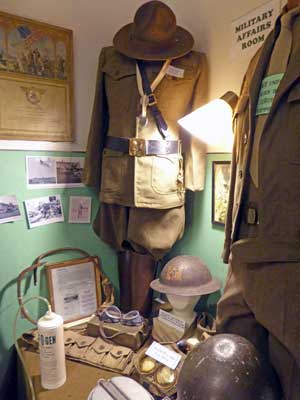
US Navy ... WWI




Unusual expression for a mannequin ... almost as if she is actually concerned about a war going on.
A tribute to Bud, a Caldwell dog who went from here to Vermont as a companion on the first coast-to-coast auto trip:

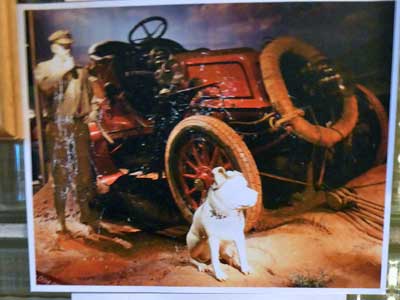
In 1903, cars were still viewed as a rich man's toy... an impractical novelty. They were expensive, uncomfortable and broke down often. While on vacation in San Francisco, Vermont doctor Horatio Nelson Jackson got involved in a dinner debate as to whether a car was even capable of driving all the way across country. He (after accepting a bet) bought a 1903 Winton and hired a mechanic to accompany him. He removed the car's back seat to make storage space for tools, spare parts and camping equipment.
After only 15 miles out, they blew a tire. Eventually they got so many flats that they often had to wind ropes around the rim until a new tire could be found. Also, there were no gas stations so they had to purchase cans of gas (used for farm machinery) at rural general stores. The dirt roads back then were designed for horses, so the car often got stuck in mud patches. Where there were no roads, they had to go cross-country over bare ground. A broken axel had to be welded back together by a local blacksmith. Another time, one of the engine's connecting rods broke, so he had to telegraph the manufacturer in Ohio and wait for replacement parts to arrive by train. Jackson also didn't have any road maps. At one point, he was sent 108 miles out of his way by a local direction-giver simply who wanted the car to drive past a relative's house (since they'd never seen a car before).
In Idaho, he picked up another traveling companion, a pit bull named Bud. Bud was even given his own pair of goggles to protect his eyes from dust (back then, cars didn't have windshields). They arrived in New York City in 63 days, thus establishing the car as a viable alternative to railroads for long-distance travel.
An office filled with the family history of some of the building's former owners:




(right) The doll's dress was actually worn by a family member in 1905.
Another hallway of the extensive building:

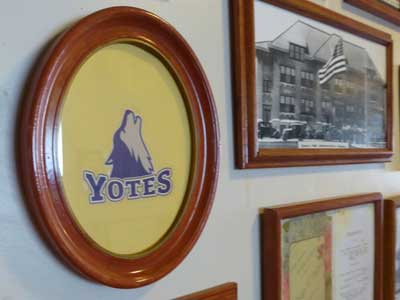




Wow, the museum had simply everything! ... Folding seats from the old theater
The bakery and store exhibits were in the old EKG room:


The bakery ... with yummy-looking plastic treats


Homemade ice-cream ... An assortment of candy. I asked Lita about the Idaho Spud and she said they still made them!


The store ... purple bottles
These lavender or amethyst bottles started out as clear glass! But the manganese oxide which is used to make glass clear can become ionized by the sun's ultraviolet light and over time this turned them purple. Manganese came from Germany, so when WWI was happening, it was no longer being shipped to America. As such, glass companies started using selenium oxide instead. Therefore, if you ever see an amethyst bottle, it was almost certainly made in the late 1800s or before 1915.


Malt machine ... scale


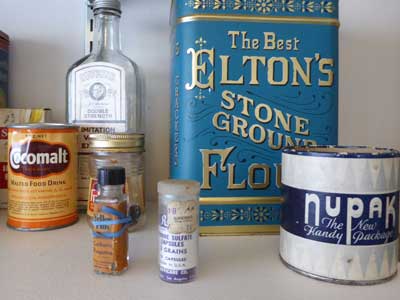


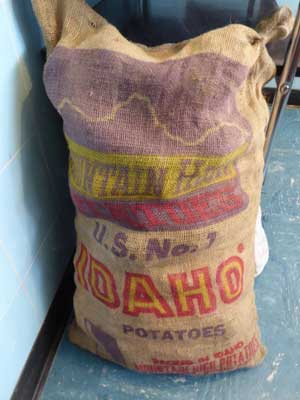
A creamery exhibit:


Dairyman's Cooperative Creamery of Boise Valley


1926
return • continue

